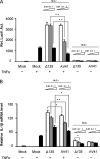The 135 Gene of Goatpox Virus Encodes an Inhibitor of NF-κB and Apoptosis and May Serve as an Improved Insertion Site To Generate Vectored Live Vaccine
- PMID: 29950422
- PMCID: PMC6146686
- DOI: 10.1128/JVI.00190-18
The 135 Gene of Goatpox Virus Encodes an Inhibitor of NF-κB and Apoptosis and May Serve as an Improved Insertion Site To Generate Vectored Live Vaccine
Abstract
Goatpox virus (GTPV) is an important member of the Capripoxvirus genus of the Poxviridae Capripoxviruses have large and complex DNA genomes encoding many unknown proteins that may contribute to virulence. We identified that the 135 open reading frame of GTPV is an early gene that encodes an ∼18-kDa protein that is nonessential for viral replication in cells. This protein functioned as an inhibitor of NF-κB activation and apoptosis and is similar to the N1L protein of vaccinia virus. In the natural host, sheep, deletion of the 135 gene from the GTPV live vaccine strain AV41 resulted in less attenuation than that induced by deletion of the tk gene, a well-defined nonessential gene in the poxvirus genome. Using the 135 gene as the insertion site, a recombinant AV41 strain expressing hemagglutinin of peste des petits ruminants virus (PPRV) was generated and elicited stronger neutralization antibody responses than those obtained using the traditional tk gene as the insertion site. These results suggest that the 135 gene of GTPV encodes an immunomodulatory protein to suppress host innate immunity and may serve as an optimized insertion site to generate capripoxvirus-vectored live dual vaccines.IMPORTANCE Capripoxviruses are etiological agents of important diseases in sheep, goats, and cattle. There are rare reports about viral protein function related to capripoxviruses. In the present study, we found that the 135 protein of GTPV plays an important role in inhibition of innate immunity and apoptosis in host cells. Use of the 135 gene as the insertion site to generate a vectored vaccine resulted in stronger adaptive immune responses than those obtained using the tk locus as the insertion site. As capripoxviruses are promising virus-vectored vaccines against many important diseases in small ruminants and cattle, the 135 gene may serve as an improved insertion site to generate recombinant capripoxvirus-vectored live dual vaccines.
Keywords: GTPV 135; NF-κB pathway; apoptosis; viral vector.
Copyright © 2018 American Society for Microbiology.
Figures






Similar articles
-
Comparative evaluation of three capripoxvirus-vectored peste des petits ruminants vaccines.Virology. 2018 Jan 15;514:211-215. doi: 10.1016/j.virol.2017.11.015. Epub 2017 Dec 1. Virology. 2018. PMID: 29197721
-
A G-protein-coupled chemokine receptor: A putative insertion site for a multi-pathogen recombinant capripoxvirus vaccine strategy.J Immunol Methods. 2017 Sep;448:112-115. doi: 10.1016/j.jim.2017.05.007. Epub 2017 May 31. J Immunol Methods. 2017. PMID: 28576653
-
Construction of an attenuated goatpox virus AV41 strain by deleting the TK gene and ORF8-18.Antiviral Res. 2018 Sep;157:111-119. doi: 10.1016/j.antiviral.2018.07.008. Epub 2018 Jul 17. Antiviral Res. 2018. PMID: 30030019
-
Construction of recombinant capripoxviruses as vaccine vectors for delivering foreign antigens: Methodology and application.Comp Immunol Microbiol Infect Dis. 2019 Aug;65:181-188. doi: 10.1016/j.cimid.2019.05.013. Epub 2019 May 18. Comp Immunol Microbiol Infect Dis. 2019. PMID: 31300111 Review.
-
Capripoxvirus-vectored vaccines against livestock diseases in Africa.Antiviral Res. 2013 May;98(2):217-27. doi: 10.1016/j.antiviral.2013.02.016. Epub 2013 Mar 7. Antiviral Res. 2013. PMID: 23499648 Review.
Cited by
-
Exploring the function and pathogenicity of Goatpox virus N1L gene using recombinant vaccinia virus Tiantan strain.Front Vet Sci. 2025 Jul 7;12:1622506. doi: 10.3389/fvets.2025.1622506. eCollection 2025. Front Vet Sci. 2025. PMID: 40693109 Free PMC article.
-
Capripoxvirus Infections in Ruminants: A Review.Microorganisms. 2021 Apr 23;9(5):902. doi: 10.3390/microorganisms9050902. Microorganisms. 2021. PMID: 33922409 Free PMC article. Review.
-
Lumpy Skin Disease Virus with Four Knocked Out Genes Was Attenuated In Vivo and Protects Cattle from Infection.Vaccines (Basel). 2022 Oct 12;10(10):1705. doi: 10.3390/vaccines10101705. Vaccines (Basel). 2022. PMID: 36298570 Free PMC article.
-
Molecular phylogenetics of a recently isolated goat pox virus from Vietnam.BMC Vet Res. 2021 Mar 8;17(1):115. doi: 10.1186/s12917-021-02777-1. BMC Vet Res. 2021. PMID: 33685458 Free PMC article.
-
NF-κB as an Important Factor in Optimizing Poxvirus-Based Vaccines against Viral Infections.Pathogens. 2020 Nov 29;9(12):1001. doi: 10.3390/pathogens9121001. Pathogens. 2020. PMID: 33260450 Free PMC article. Review.
References
-
- Lazaro-Frias A, Gomez-Medina S, Sanchez-Sampedro L, Ljungberg K, Ustav M, Liljestrom P, Munoz-Fontela C, Esteban M, Garcia-Arriaza J. 2018. Distinct immunogenicity and efficacy of poxvirus-based vaccine candidates against Ebola virus expressing GP and VP40 proteins. J Virol 92:e00363-18. doi:10.1128/JVI.00363-18. - DOI - PMC - PubMed
-
- Saunders KO, Santra S, Parks R, Yates NL, Sutherland LL, Scearce RM, Balachandran H, Bradley T, Goodman D, Eaton A, Stanfield-Oakley SA, Tartaglia J, Phogat S, Pantaleo G, Esteban M, Gomez CE, Perdiguero B, Jacobs B, Kibler K, Korber B, Montefiori DC, Ferrrari G, Vandergrift N, Liao HX, Tomaras GD, Haynes BF. 2018. Immunogenicity of NYVAC prime-protein boost human immunodeficiency virus type 1 envelope vaccination and simian-human immunodeficiency virus challenge of nonhuman primates. J Virol 92:e02035-17. doi:10.1128/JVI.02035-17. - DOI - PMC - PubMed
-
- Haagmans BL, van den Brand JM, Raj VS, Volz A, Wohlsein P, Smits SL, Schipper D, Bestebroer TM, Okba N, Fux R, Bensaid A, Solanes Foz D, Kuiken T, Baumgartner W, Segales J, Sutter G, Osterhaus AD. 2016. An orthopoxvirus-based vaccine reduces virus excretion after MERS-CoV infection in dromedary camels. Science 351:77–81. doi:10.1126/science.aad1283. - DOI - PubMed
Publication types
MeSH terms
Substances
LinkOut - more resources
Full Text Sources
Other Literature Sources
Research Materials

